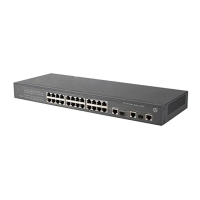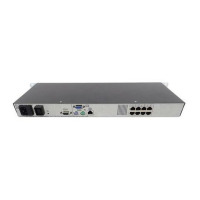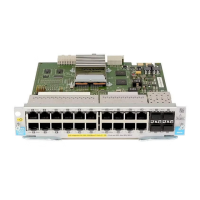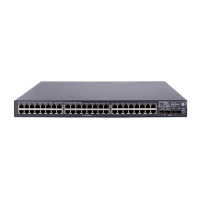69
Configuring the network diameter of a switched
network
Any two terminal devices in a switched network are connected through a specific path composed of
a series of devices. The network diameter is the number of devices on the path composed of the
most devices. The network diameter is a parameter that indicates the network size. A bigger network
diameter indicates a larger network size. Based on the network diameter you configured, the system
automatically sets an optimal hello time, forward delay, and max age for the device.
To configure the network diameter of a switched network:
Step Command Remarks
1. Enter system view.
system-view
N/A
2. Configure the network
diameter of the switched
network.
• In STP/RSTP/MSTP mode:
stp bridge-diameter diameter
• In PVST mode:
stp vlan vlan-list bridge-diameter
diameter
Use one of the
commands.
The default setting is 7.
NOTE:
• In STP/RSTP/MSTP mode, each MST region is considered as a device and the configured
network diameter is effective only for the CIST (or the common root bridge), but not for MSTIs.
• In PVST mode, the network diameter configuration is effective on the root bridge only.
Configuring spanning tree timers
The following timers are used for spanning tree calculation:
• Forward delay
It is the delay time for port state transition. To prevent temporary loops on a network, the
spanning tree sets an intermediate port state, the learning state, before it transitions from the
discarding state to the forwarding state, and requires that the port transitions its state after a
forward delay timer to make sure that the state transition of the local port keeps synchronized
with the peer.
• Hello time
The device detects whether a link failure has occurred with the hello time interval. The spanning
tree sends a configuration BPDU every hello time interval. If the device receives no
configuration BPDUs within the hello time interval, it recalculates the spanning tree.
• Max age
In the CIST of an MSTP network or each VLAN of a PVST network, the device uses the max
age parameter to determine whether a configuration BPDU received by a port has expired. If a
port receives a configuration BPDU that has expired, that MSTI must be re-calculated. The max
age timer is ineffective for MSTIs.
To avoid frequent network changes, be sure that the settings of the hello time, forward delay
and max age timers meet the following formulas:
{ 2 × (forward delay – 1 second) ≥ max age
{ Max age ≥ 2 × (hello time + 1 second)
Hewlett Packard Enterprise does not recommend you to manually set the spanning tree timers.
Instead, you can specify the network diameter and let spanning tree protocols automatically

